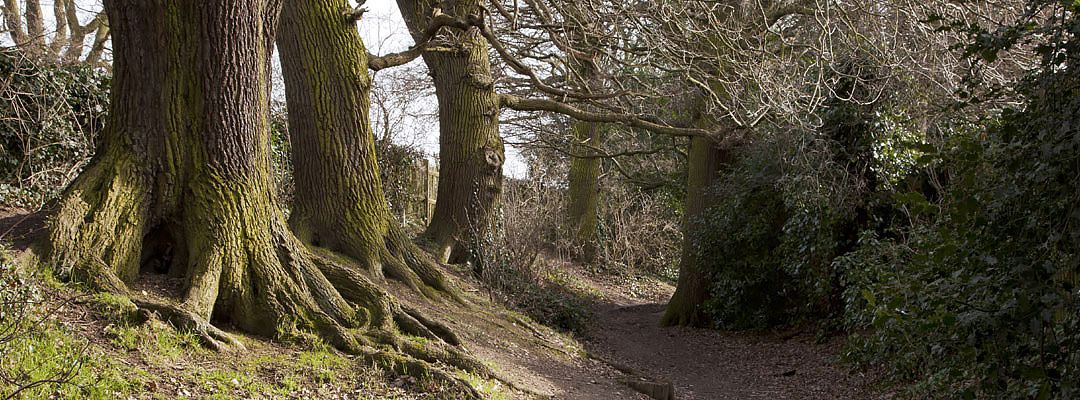Iron Age Kings and their Roman Connections
The burial goods from Lexden Tumulus and the earthworks of Bluebottle Grove in Essex provide tantalising glimpses of rich and powerful leaders in Iron Age Britain, and their strong links with the Roman world.

TRIBAL STRONGHOLDS
The late 1st century BC is the earliest period for which we have written sources for the history of Britain to supplement what we know from archaeology – a confluence that marks the end of prehistory. Together they hint at a complex world of power and intrigue.
The earliest parts of the extensive system of massive linear banks and ditches of pre-Roman Colchester (Camulodunum), which include Bluebottle Grove, date from this period. These and later earthworks enclose more than 12 square miles.
These earthworks belong to a type of defended site known as oppida, likely to have been the strongholds of tribal elites, which appear during the 1st century BC – particularly across southern and eastern England. Other examples include Chichester Entrenchments (West Sussex), Silchester (Hampshire), and Verulamium (St Albans, Hertfordshire).
These are much larger than the more familiar hillforts of the Iron Age, such as Maiden Castle in Dorset. It is likely that they developed after most hillforts fell out of use.
ROMAN INVASION
The earliest elements of Camulodunum date to between 50 and 25 BC, but why they were built, and by whom, remains a mystery.
Julius Caesar’s own account of his wars with the Gauls tells us that he made two incursions into the south of England (in 55 and then 54 BC). Tribal unities extended across the Channel at this time and one group, the Belgae, are reported to have fled to England during the wars.
Camulodunum developed in what was the territory of the Trinovantes tribe. It has been suggested that they, like the Belgae, had their roots in continental Europe, and may have fled across the Channel from the fight with Caesar. Alternatively they may have been established as one of the so-called client (pro-Roman) kingdoms by the Romans, in advance of Caesar’s invasion.
The first earthworks of Camulodumum may well have been built as a response to the threat of attack from other tribes, probably the Catuvellauni.
GRAVE GOODS
We know from coin evidence that Addedomarus, king of the Trinovantes, moved his capital to Camulodunum in about 25 BC. It is probably Addedomarus who was buried in the Lexden Tumulus, the best known of many pre-Roman graves found in the area.
Here, between 15 and 10 BC, in a pit beneath a large, circular mound, a mature man was buried, surrounded by many luxurious objects of both Celtic and Roman origin. They included bronze figurines, a suit of chain mail, silverwork and goldwork, and a small medallion of the Roman emperor Augustus dated to between 19 and 15 BC – presumably a mark of Roman favour.
This was in fact a time of increasing contact with Rome. Addedomarus’s son Dubnovellaunus at one stage sought protection in Rome, and shortly before AD 10 unnamed British rulers sent embassies to Augustus.
CYMBELINE
Camulodunum was also home to one of the most important leaders in pre-Roman Britain: Cunobelin, leader of the Catuvellauni, who displaced Dubnovellaunus, Addedomarus’s successor, in about AD 9. Cunobelin’s coins, first issued in that year, bear the mint mark CAMU (for Camulodunum), and the image of Cunobelin is cast in a Roman style.
Cunobelin – the inspiration for Shakespeare’s Cymbeline – reigned for about 30 years, and seems to have greatly extended his tribal territory at the expense of neighbouring tribes like the Trinovantes. He was referred to by the Roman historian Suetonius as ‘King of the Britons’.
Although he is always identified with Camulodunum, ironically Cunobelin probably did not build many of its defences – probably because there was never any serious threat to his rule.
A FINE LIFE
Though the evidence is fragmentary, oppida like Camulodunum seem to have been important royal centres of power in the final decades before the Roman invasion of AD 43.
And far from being the barbarians of stereotype, Cunobelin and his predecessors evidently enjoyed great wealth and the trappings of a fine lifestyle. Trade links with Rome were strong: we know that Cunobelin imported luxury goods – such as wine, fine metalwork and pottery – from the Roman empire, in exchange for British products.
Our Essex ancestors clearly loved a bit of Roman bling.
By David McOmish
